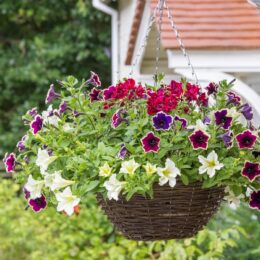
A bug hotel is a fantastic way to encourage insects into your garden. Attracting beneficial insects such as pollinators will keep your garden thriving with plants and flowers and pest eating bugs like ladybirds will keep nasty aphids from destroying plants.
It is important to support insects and pollinators as much as we can as habitats are decreasing due to developments taking over their natural homes.
Bug hotels can be purchased ready-made – we stock a good range from a simple lady bird log to a five start hotel! Or, it is very straight forward and fun to create your own, and it really can be as simple as a log pile or as elaborate as you like. We hope our ideas inspire you to create your own!
Simple – This is a baked bean tin from our coffee shop: 
Elaborate – This is a five-star crate hotel built by our Garden Explorers, it resides in our car park at Tiptree:
How to build your insect home:
What to use as a base:
- Wooden pallets
- Crates
- An old tyre
- Flower pots
- An old book case or shelf unit
- Used tins or containers
Choosing a good spot for your insect home. Firstly, most insects like cool, moist conditions, so a shady area next to a hedge or under a tree works well. Secondly, make sure the home has a firm base, because it will end up being quite heavy once it’s been filled with all your materials, unless of course you plan ahead and build it where it’s going to stay!
One of our team built a log wall for their garden, the insects love it!

What to fill your hotel with:
The trick is to pack your hotel as tightly as you can using:
Logs, twigs & rotting wood makes a great home for wood-boring beetles, such as the majestic stag beetle, and their larvae.
Rotting wood and bark are where beetles, centipedes, spiders and woodlice love to be. Woodlice and millipedes break down wood plant material and are an important part of your garden recycling system.
Hollow stems, bamboo canes, and holes drilled into blocks of wood are all ideal spots for solitary bees to lay their eggs. These bees help pollinate flowers (so helping your plants produce vegetables) in the garden. Place these materials on the sunniest side.
Broken bricks, stones and tiles provide cool, moist conditions for frogs and newts. These will be best lower down, on the shadiest side.
Hay and straw give insects a good place to burrow and hibernate.
Dry leaves are great for ladybirds as they hibernate here over winter
Corrugated cardboard rolled up inside a plastic bottle (recycling is always good to do) will attract lacewings, which are really good at eating pests.
During lock down some of our team got creative and made some fantastic hotels:
Made from an old book shelf – 
And a boxed frame – 
A few fun facts :
A ladybird can eat as many as 5,000 aphids in its lifetime.
A bee’s wings beat 190 times a second, that’s 11,400 times a minute.
The stag beetle is the largest species of insect to be found in the UK.





